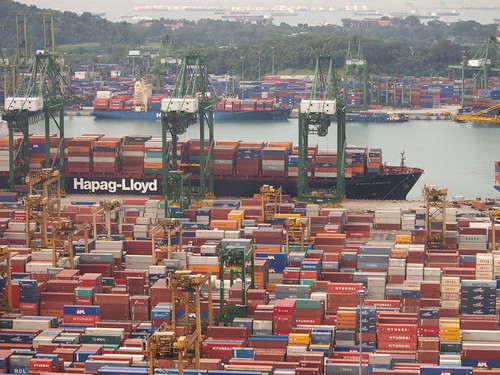
SEOUL – If you chase two rabbits at once, the old saying goes, both will escape. And yet this is precisely what many governments are required to do: pursue both growth and distributional fairness. The two objectives, though not incompatible, are entirely different from one another, and few policy tools can simultaneously help to achieve both.This idea matters a lot in trade policy. Much theoretical and empirical research demonstrates that opening trade can spur a country’s GDP growth. But increasing a pie’s size does not guarantee that it will be shared fairly.
Often, the incremental growth that comes with a trade opening is unevenly shared; moreover, in many cases, some receive a smaller share than they did before. Here is where government must intervene using its traditional tools, taxation and redistribution, as well as complementary policies such as social safety nets and adjustment assistance.
Similarly, from a global perspective, opening trade can contribute to the world’s overall economic growth, but does not guarantee that the benefits will be fairly distributed among countries. Some say that no country loses, in absolute terms, from opening trade; otherwise, they would not participate in free-trade deals. Still, the uneven distribution of the benefits created by a global trade opening means that some countries, especially the least developed, gain little in comparative terms, and are possibly even hurt.
This explains growing concern about the role of trade in development, despite the obvious fact that increased global trade has lifted hundreds of millions of people out of poverty in recent decades. Unlike individual countries, there is no central authority that can enforce redistribution of wealth around the globe, so the problem of fairness must be addressed through the development mandates embedded in trade negotiations.
A key aspect of these development concerns is identifying the appropriate balance in any trade agreement. “Special and differential treatment” is the technical term used in trade negotiations to indicate that the balance must be tilted toward developing countries, with the extent of this treatment to be decided by the parties to the talks. But, while the tendency in current trade negotiations to allow developing countries to open their markets less than others helps to achieve more balance, it may undermine the original goals of enhancing efficiency and boosting growth. Furthermore, it fails to encourage more South-South trade.
And, in the end, this focus on the defensive side of trade liberalization makes negotiations more difficult. For example, one of the critical issues blocking progress on the World Trade Organization’s Doha Development Agenda of global free-trade talks centers on the extent to which major developing countries should open their markets.
A better method of seeking balance is to give developing countries greater access to global markets, including those of other developing countries. Yet, as of now, there is neither the will nor the energy to adopt this approach. And, for developing countries that lack supply-side capacity, greater access to the global market is a moot point, as they remain far from even considering what size their share of it should be.
This raises another concern. Because “aid for trade” – assistance for developing countries that aims to ease their trade-related constraints – takes the form of financial support, a practical issue is whether donors can maintain their level of funding, given today’s economic difficulties. Moreover, an intrinsic and often neglected problem is how to divide management of aid-and-trade schemes among international and domestic institutions.
Among the major multilateral institutions, the WTO maintains jurisdiction over trade. It is the World Bank and the International Monetary Fund that are better equipped to deal with aid issues. Within member governments, relations with the WTO are usually the responsibility of the trade or foreign ministry, while multilateral financial institutions, including the regional development banks, are generally the responsibility of the finance ministry.
Thus, aid for trade, one of the key tasks on the WTO agenda, has weak institutional links to trade negotiations. In fact, it might be more accurate to say that it is wholly separate.
The practicable solution is more effective coordination among the relevant institutions. The Marrakesh Agreement, which established the WTO as the successor to the General Agreement on Tariffs and Trade in 1994, sets out the purpose of achieving greater coherence between the WTO and other international agencies. One particularly noteworthy initiative is the Enhanced Integrated Framework for least-developed countries, which encompasses extensive engagement and coordination among partner agencies, including the IMF, the United Nations Conference on Trade and Development, the World Bank, and the WTO.
A more ambitious approach would be to link aid and trade explicitly. A concrete funding mechanism in trade agreements warrants serious consideration, particularly in areas such as the WTO’s trade-facilitation negotiations, where capacity-building in developing countries is a key issue.
Nonetheless, requiring donations from member countries would be a step in the wrong direction; the WTO is not an aid agency. Rather, WTO trade agreements could establish effective links with multilateral and regional development banks, thereby helping to realize the principle of closer international coordination set out in the Marrakesh Agreement.
The two rabbits of international trade can be caught. But doing so requires innovative approaches that help to ensure that trade serves developing countries, rather than vice versa.
For additional reading on this topic please see:
International Trade: Rules of Origin
International Trade and Finance: Key Policy Issues for the 113th Congress
The Proposed US-Colombia Free Trade Agreement
For more information on issues and events that shape our world please visit the ISN’s featured editorial content and Security Watch.

